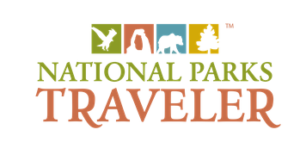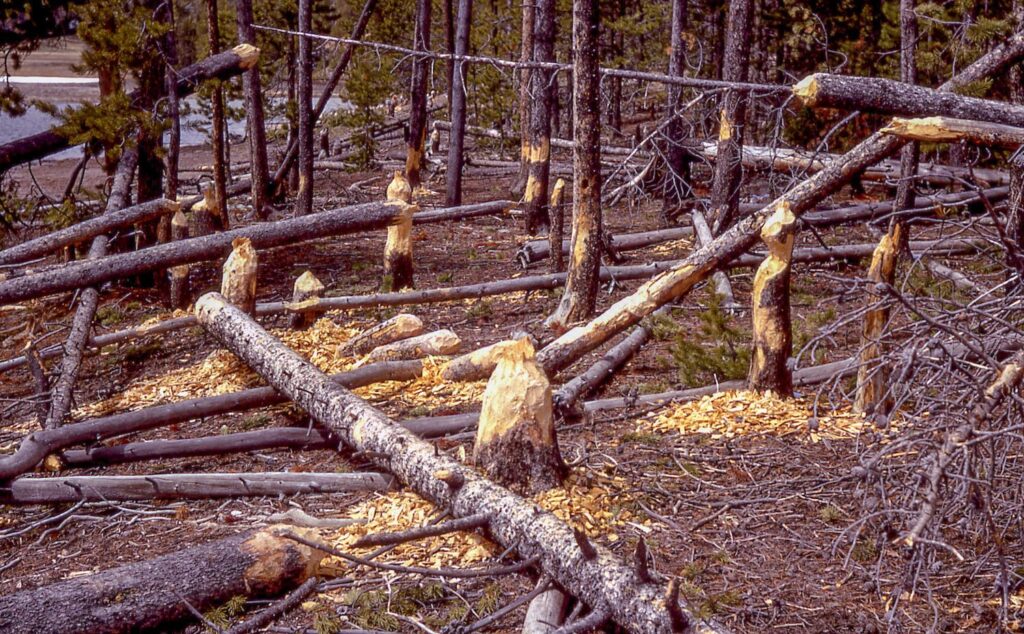I guess things are wrapping up all over, because this recent article on the beavers in Yellowstone is the final from the glorious beaver serious in the National Park Traveler. I’m going to miss them.
Yellowstone’s Resilient Beavers
While Yellowstone continues to be good beaver habitat, it’s not as robust as the Adirondacks. Through the decades the population has varied greatly. In recent years, the park’s beaver population probably has hovered around 1,000 spread out across roughly 140 colonies. But that number took a blow last summer, as the historic flooding that swept through the northern reaches of Yellowstone likely took out many of those colonies.
Doug Smith, until recently the park’s wildlife biologist, flew over the park in October to see how many colonies he could spot and came away with a tally of 65 park-wide, which was down from 108 in 2021. With each colony home to 6-8 individuals, there might be about 500 beavers left in Yellowstone.
Whether those colonies impacted by the flooding return remains to be seen.
“It seems like what they do — and we don’t have any radioed to know — but I think these big water events, they just find a place to hide out, whether it’s in a burrow they’ve dug on the side of the river or they just find above-ground places,” said Smith prior to his aerial surveillance. “Or they just get blown down river and they hang out. They seem to casually just infiltrate back. They’re pretty resilient to these natural disasters. That’s why I think they’re good for what you’re writing about. I think they’re a good form of ecological restoration because they’re so damn resilient.”
And they benefit so many other species.
“A beaver pond is going to be an oasis. And it’s going to be a biodiversity hub,” said Smith. “They always are biodiversity hubs. I mean, it’s just amazing. When you add water to any mix, what they do, it’s truly amazing.”
That’s right. The Beavers are the inherent masters of the serenity prayer. They wisely accept thing things they cannot change and get the hell out of the way when the water is raging. And change the things they cannot accept building dams and making channels so that streams flourish even in a drought. And despite those studies arguing that they are not very bright seem to have the wisdom to know the difference,
Way better than us.
 Though Yellowstone is roughly 10 times the size of both Voyageurs and Isle Royale national, it can’t boast as many beavers as those two do, said Smith, who retired in December. Apparently holding back the park’s beaver population, the biologist explained, is that they don’t like swift currents or coniferous trees for food, and Yellowstone has lots of both.
Though Yellowstone is roughly 10 times the size of both Voyageurs and Isle Royale national, it can’t boast as many beavers as those two do, said Smith, who retired in December. Apparently holding back the park’s beaver population, the biologist explained, is that they don’t like swift currents or coniferous trees for food, and Yellowstone has lots of both.
Through the decades Yellowstone’s beaver populations have varied greatly. A 1921 survey turned up only 25 colonies, although that was a limited survey. Thirty-two years later, 21 colonies were identified, but none in the areas surveyed in 1921. In a bid to help the rodents, 129 beavers from the Gallatin National Forest north of Yellowstone were set free in the park between 1986 and 1999. While that helped boost the numbers, the beaver population continued to fluctuate, ranging between 112 and 127, according to the park staff.
Steadily driving beaver numbers upward in Yellowstone has been willow recovery, said Smith, as it gave the rodents a reliable food source. In the 1990s, the effort to return wolves to the park led to a drop in elk numbers, and that allowed willow stands to rebound, and beaver numbers began to climb, he explained. Also impacting the elk population was the presence of other predators — cougars and bears — and even elk management by the state of Montana outside the park, explained Smith.
Along with overall lower elk numbers, the predators caused the remaining ungulates to alter their movements and that, too, played a part in allowing willow recovery, said Smith.
“The key was a reduction in the elk population allowed willow to come back, which gave beavers a food source,” the biologist said.
From Aspen To Willow
An interesting aspect of Yellowstone’s beaver history is that the animals shifted their diet over the decades, from aspen to willow. When Edward Warren conducted his survey in the 1920s, he saw that the rodents’ preferred forage was aspen. Today, “virtually all the beavers in northern Yellowstone are eating willow,” said Smith.
“So, the story is kind of an abundant population, using willow, a population crash, a long period of time with very few beavers, and then a recovery based on an interaction with elk and predators, but the recovery is entirely dependent upon willow,” he explained.
Willow Willow Willow. I’m curious what the difference is between the range of Aspen and Willow now. If beavers have equal access to flourishing populations of both or if one grows father from the waterline or is less affected by Caribou browse.
 Those years when the species’ population crashed also created hurdles for beaver recovery.
Those years when the species’ population crashed also created hurdles for beaver recovery.
“Decades with very few beavers changed stream geomorphology. So watching a few of the sites that beavers are reoccupying, they’re having a hard time because of stream rescission,” said Smith. “The streams have straightened and deepened,” making it tough for beaver colonies to get established.
“I’ve watched one colony bounce around in different locations. They’ve got good forage, but they can’t seem to find a good pond site,” he said. In their search for a suitable site the beavers in 2021 moved further upstream on Crystal Creek and were able to dam the stream and create a pond, added Smith.
Whether they survived the flooding remains to be seen.
While some other national parks are looking to beavers to help with restoration or areas impacted by wildfires or overgrazing, at Yellowstone the beavers are just being beavers.
“We probably have beavers at capacity,” said Smith. “They’re doing the job on their own.”
Yes well when you trap out all the beavers and the streams run wild and incise into crazy chutes and them bring a couple of beavers back and notice that all the dams keep washing out its NOT because these new beavers are lazy. Any more than if your entire engine was allow to rust and you finally got around to replacing the carburator and you’re surprised the car doesn’t run as well as it used to.
It all works together. Beavers. Wolves, Rivers. It doesn’t work as well when you start taking things away. And beavers need beavers making dams upstreams of their their dams so that the water has a chance keeping manageable.
It’s a fascinating job, as Warren pointed out in 1922 in a booket he wrote on Yellowstone’s beavers.
“The value of the beaver to the Park visitor is something rather difficult to put into words, but the creature has a real fascination for the intelligent tourist. Here is an animal of most interesting habits which was once to be found over the greater part of the United States but has since been exterminated from large areas, yet has left traces of its former presence in such place names as Beaver Brook, Creek, Kill, River, Lake, Falls, Hil], Dam and Meadow,” wrote Warren. “It can still be found in abundance in many parts of Yellowstone Park and the surrounding National Forests, affording opportunity for observing its habits and studying: its works. Surely this is a valuable privilege for all who can visit the great Park.”
Well yes. The public does like seeing beavers. But that’s just the icing. Biodiversity. Stream restoration. Climate change and pollution mitigation. The wisdom to know what to accept and what to fix?
That’s the cake.






































